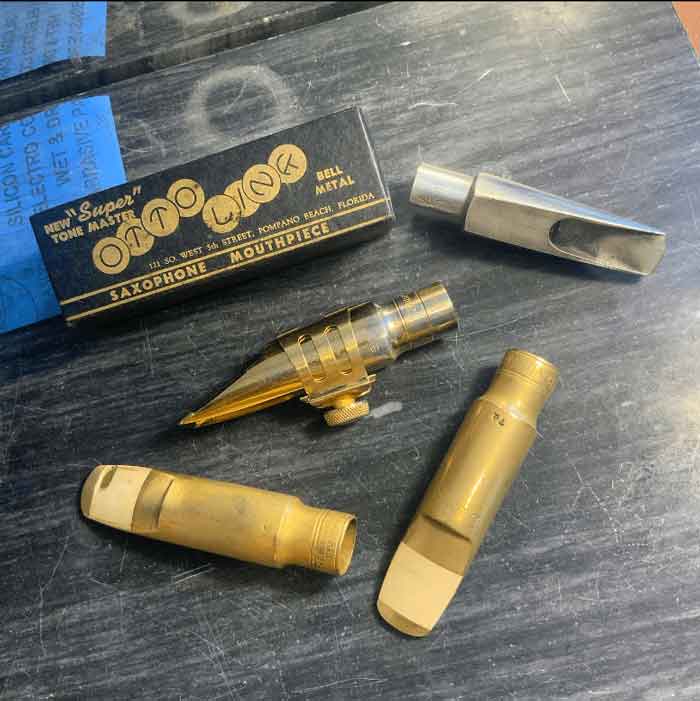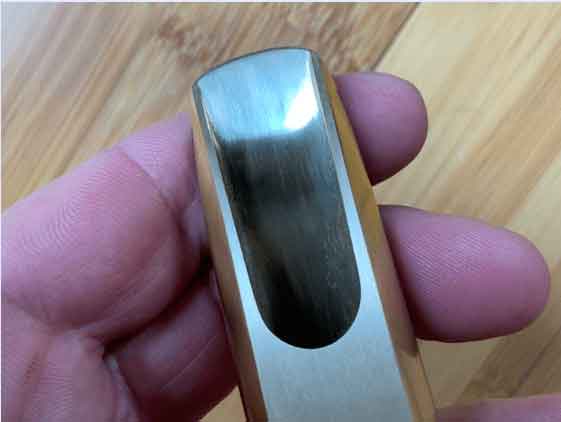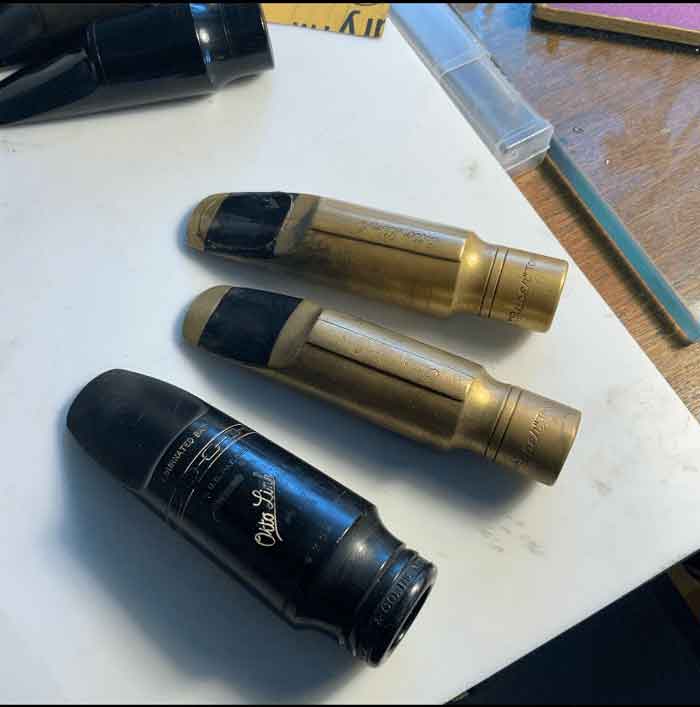The Art of Mouthpiece Refacing with Thomas Occhiuto
Introduction
When it comes to making a mouthpiece change, the question as to whether to purchase a new one or to reface a mouthpiece you already own comes up quite a bit, and the answer really depends on your situation and why it is you are looking to make a change.
In the past when I was not happy with my setup, I started the search for a new mouthpiece to solve my perceived mouthpiece problems. And many times, making the change to a new piece did solve my problems…temporarily. Too many times, it was not long after replacing a mouthpiece that I was once again on the hunt for my next piece.
It wasn’t until college that I learned a bit more about mouthpiece refacing. More specifically, what could be achieved by having your current or backup mouthpiece refaced by a professional refacer, and exactly who were the go-to pros in the world of mouthpiece refacing.
Recently, while meeting up with Tim Lin, saxophonist and owner of The Bebop Sax Shop, I had the opportunity to try some of his Dukoff Stubby tenor pieces, which were absolutely killing, and I later found out were all refaced by saxophonist and mouthpiece refacer Thomas Occhuito. Now for those of you who don’t know Tommy, here is a quick bio below to get you up to speed.
Thomas Occhuito Bio
- Thomas Occhiuto (pronounced O-Q-tow) is a San Francisco-based professional jazz musician, educator, composer, and craftsman who specializes in custom saxophone mouthpiece refacing, and product design.
- In 2003, Occhiuto earned his degree in Jazz Studies and Performance from The University of Loyola, New Orleans. While a resident of New Orleans, he studied with saxophone greats John Ellis, Bryce Winston, and Tony Dagradi while playing professionally in traditional and contemporary performance settings until his move to the Bay Area in 2007.
- Occhiuto can often be seen performing with members of Adam Theis’s Jazz Mafia, as well as a consortium of the Bay Area’s most prominent musicians, in addition to his own quartet, Henchman Street.

Interview
ZS: What got you into refacing mouthpieces? Did you apprentice under another refacer or learn by trial and error?
TO: It’s a funny way I got into this. It starts from having really meager resources and as a young saxophone player. I didn’t really have the option to consider a “step-up piece” and got what I got. I think it wasn’t until someone was in my ear about “oh this is the same brand of mouthpiece that Coltrane played” that I was like “oh, there is something different from that one compared to mine.”
That gave me that idea that changing that part of the instrument is going to make it easier or harder to play. I started out on alto which many people don’t know, and the first professional mouthpiece I owned was a modern metal Otto Link Super Tone Master. It sounded ok and I didn’t feel like it made me sound better or worse but that was what I was going to play on.
I remember showing up my freshman year to college with a Bundy II and the same Otto Link Super Tone Master, and the teacher that was filling in for the professor at Loyola University of New Orleans was John Ellis. This was my first private lesson in College so I didn’t even have the same information young players can find these days to improve their playing. I remember John was teaching me the overtone series, as he has one of the most amazing sounds, and I thought “how do I get to sound like that?”
I was complaining during the lesson about my alto and I said I think it’s my mouthpiece because a lot of my peers were wondering why I was playing that setup. So what happens next is John literally takes the horn, same mouthpiece, reed, ligature, and when John played it sounded amazing.
That was a real learning experience for me in a couple different ways. Number one, there will never be a substitute for practicing and getting better. But what it did show me, however, was as you are progressing musically and changing how you want to sound, players do change gear and many pieces that seem to be original but have in fact been worked on in some way. Anyway, I spent many years after that just trying to push through my gear situation.
During the summer of my freshmen year, I worked at a big box music store in Houston and I was able to land a Berg Larsen tenor mouthpiece which I thought sounded pretty good but it had a huge tip opening. On this Berg, I tried to get that quintessential tenor sound but never could. It wasn’t until I spoke to John, and at that time noticed that he changed his equipment, and John mentioned there was this guy named Bob Ackerman, rest in peace, who has a ton of mouthpieces and this piece is supposedly a copy of a vintage mouthpiece but was hand-faced by someone.
So I called Bob and at the time the mouthpiece was over $200 which was a lot for me but I was able to scrape together the cash and once I tried this piece, it was night and day. It wasn’t like I became a shredding player overnight but it was very clear something changed by upgrading to a hand-finished mouthpiece. I realized that I spent so many years dealing with imperfect equipment and that there are so many fine parameters that can be changed to make something more expressive and more responsive, and I started becoming obsessed with that.
There was a buddy of mine who went to college and knew saxophonist and refacer, Matt Marantz a little more personally than me and we all started tinkering with mouthpieces in the early 2000’s. That early tinkering, as most people know, led to a lot of bad decisions of gear getting destroyed which also had me sourcing out mouthpieces to get them refaced.
What I realized is just because someone says they are a professional refacer doesn’t mean the mouthpiece is going to work the way you want it to work. Many refacers – most are good and others not so much – will spend time saying they have the secret way of doing it but there have to be a couple of things. Namely, the concept that there is a way to change things, and understanding what parameters change what part of the sound or feel.
As I began to understand what things I could change to fill a need or add something that was missing, I really got into that whole process. I was basically inspired at first by living refacers and how well they did it, as well as digging on some old Meyer bros pieces that weren’t touched, and these pieces were beautiful looking and high-functioning.

ZS: Many mouthpieces today are based off of some of the most sought after vintage mouthpieces: Meyer’s, Link’s, Selmer’s, Guardala’s, Dukoff’s, etc, and the list goes on. What are your thoughts on these vintage pieces, and when it comes to modern mouthpieces, why do you think the consistency from mouthpiece to mouthpiece is not always present?
TO: Unlike how it was in the past, nowadays, it’s just not cost effective for mouthpiece manufacturers to have someone on the bench spending two hours on one mouthpiece at a time to make it great. Early Meyer Bros are meticulously hand-finished and the concept behind what they did in the hand-finishing process was very much akin to someone who understands the concept and probably could play the horn really well.
Aside from the Meyer, there was a large variation in the concepts being experimented with by various mouthpiece brands. This led to a lot of variation between various brands and models such as the Otto Link Super Tone Master, where some were good and others were just ok.
We also forget that our heroes who played these models also tinkered with these mouthpieces by adding material, bending, sanding, etcetera. To some extent, there has been a somewhat increasing separation between the craftsmanship side and the business side.
ZS: When do you think it makes sense to buy a new mouthpiece versus taking one to get refaced?
TO: If you have the options, resources, and are getting serious about the saxophone, then you should try new gear. Most modern production pieces can be improved by someone who does some minimal balancing and flattening. Most refacers can do it consistently and the work will speak for itself.
Having a piece balanced at least lets it function in a symmetrical way. I would recommend that anybody who cares to know if their piece is functioning should take their piece to someone who knows how to check it out. If you have the resources then do it. It’s not the price you pay, it’s about how well it’s made and how functioning it is for your own particular needs.
ZS: With more and more mouthpiece refacers entering the scene, how do you stay ahead and competitive? How is your work different from other colleagues?
TO: I think about physiology which a lot of people don’t think about. This has come from me being able to sit with some of my saxophone heroes, who are just built differently. Someone like Bob Sheppard is a tall man, so the way he lines up to the horn is different, and as a clarinetist his air efficiency is different in terms of how he puts air into the instrument. The size of your lips matters, and when you see pictures of Coltrane and Lovano you realize how some factors can be more beneficial to players that have certain builds.
To some extent I started doing this so I could play the best mouthpiece I could get my hands on as well as help my peers because I really love to see them flourish. I keep notes on all my contacts in terms of what mouthpieces they have played and liked or did not like as well as what reeds they use, etcetera, because I want to build a relationship with my clients so I can understand where they are coming from and how I can help them achieve what they are looking for with their current setup or adjusting a new or old piece.
ZS: Why have mouthpieces increased in price over the years? Is it a cost of materials, or customer expectations which seem to demand more hand work?
TO: Since the marketplace is very open these days, you need to do the research to find out where the mouthpiece is being sourced, what level of finishing work has been done, etcetera. For example are you paying less for a mass produced CNC [Computerized Numerical Control] blank, or are you paying more for a piece that is meticulously finished?
The overall cost of labor or time has gone up as well as cost of materials, but the price of a mouthpiece is not necessarily a reflection of the amount of work, time, and design that went into producing that piece.
ZS: Any future mouthpiece projects on the horizon, or new directions you see the business going?
TO: The metal mouthpiece I am working on is something that I feel answers that problem where I have always loved what the metal mouthpiece can sound like, but I’ve always missed the warmth. I am excited because this mouthpiece is extremely hand-finished and I think I have something original to offer. That is the benefit of not being an apprentice and having to figure this out on my own.
Much of the work that came about designing this piece came from working on my clients’ mouthpieces and hearing their feedback as well as that of my peers. My goal is to release something that still keeps the soul and integrity behind this piece and holding that standard. I still have a few minor tweaks and adjustments that need to happen, but I am getting really close. The goal for this piece is to have as many of the universal components as possible that can be found on great playing pieces I have worked on in the past.
To Learn More About Thomas…
Website: https://www.occhiutowoodwinds.com/








Favorite blog posts, January 2023 | Bret Pimentel, woodwinds
January 31, 2023 @ 8:46 am
[…] Best. Saxophone. Website. Ever. (Zach Sollitto): The Art of Mouthpiece Refacing with Thomas Occhiuto […]